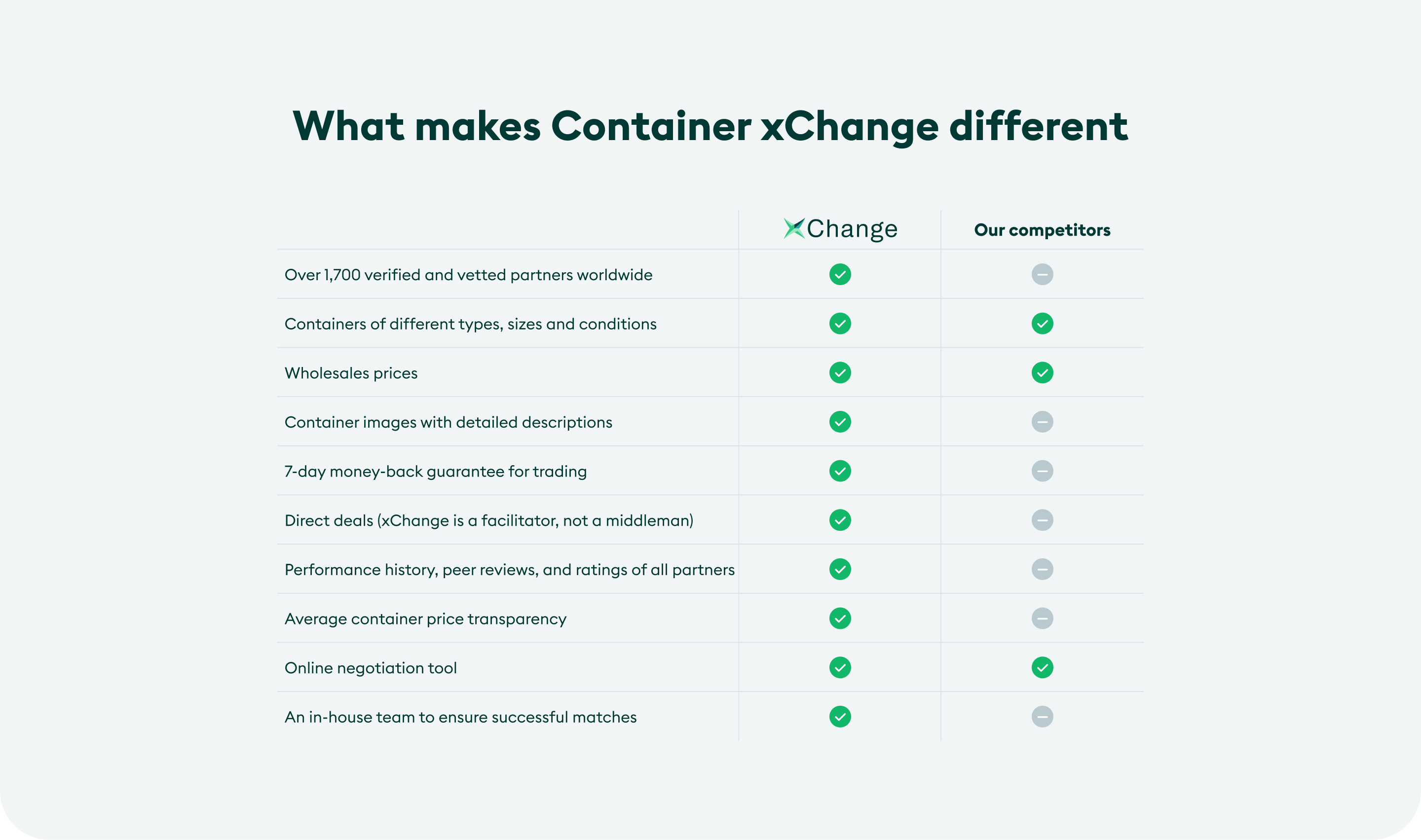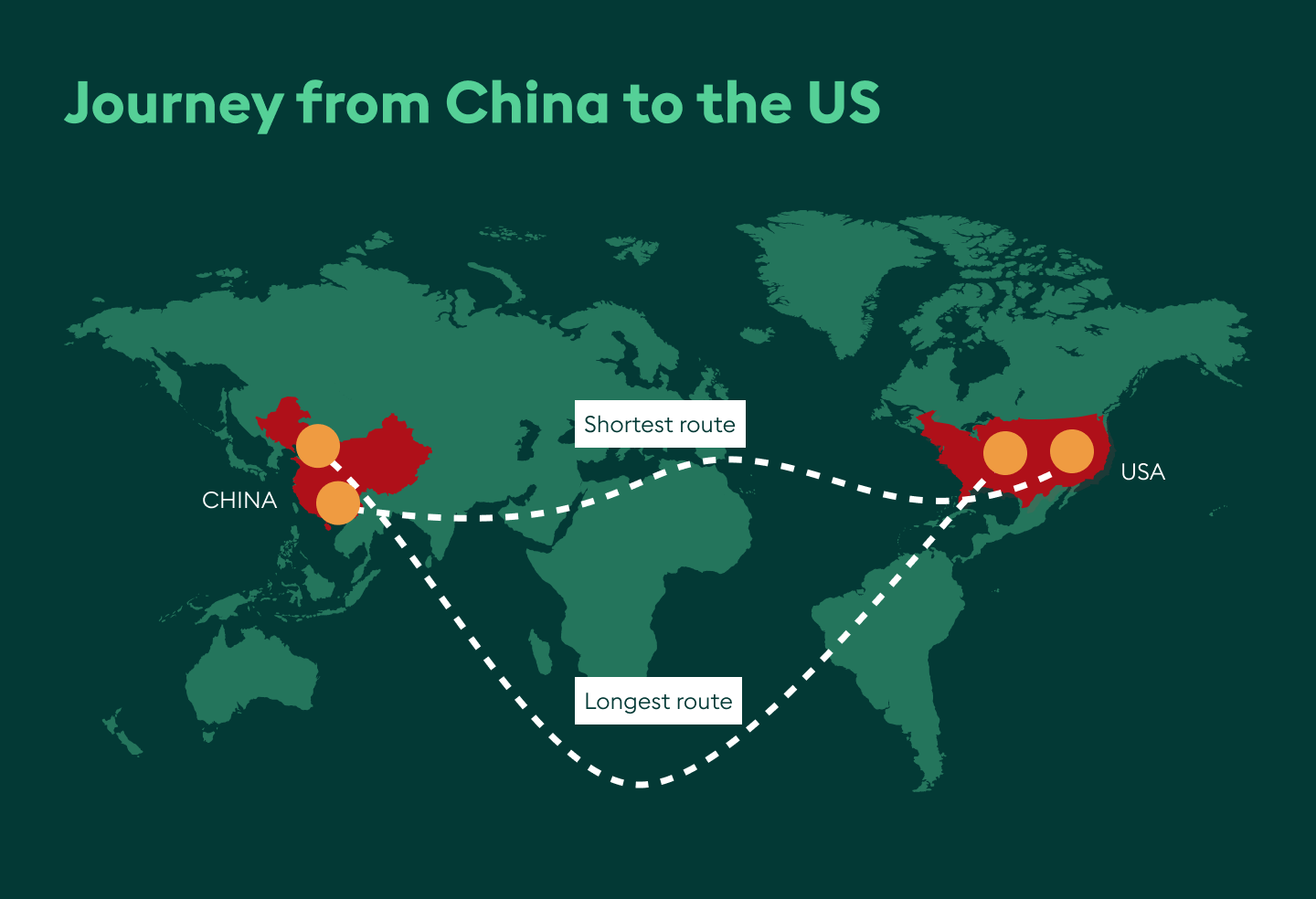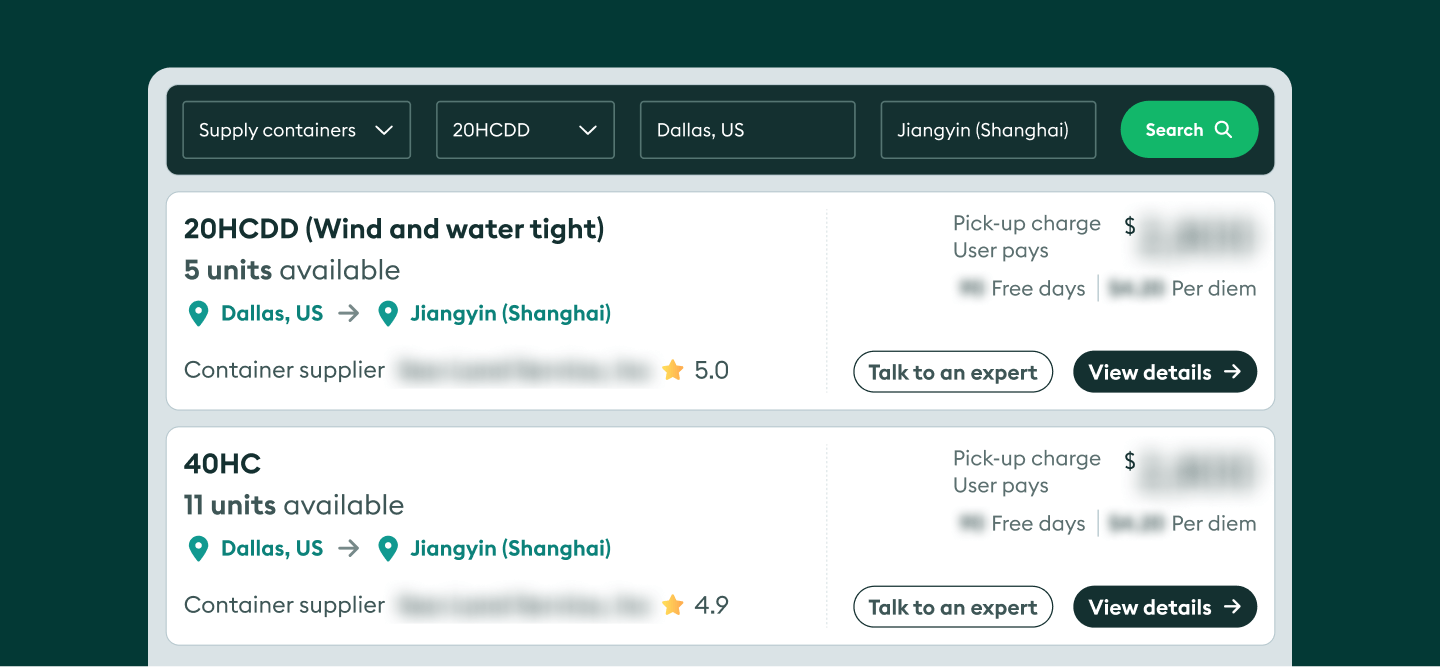Looking for a shipping container from China to USA? We’ve got you covered. In this blog, find out how to lease SOC containers at prices that suit your budget, from 1,700+ trusted suppliers hassle-free.
The China to USA route is one of the busiest and most important trade lanes in the world, representing a significant portion of global trade. China is one of the primary suppliers of goods such as furniture, textiles, and machinery to the USA and is a key market for US exports.
If you’ve got goods to ship from China to the USA and are looking for containers to lease at great rates from a reliable sourcing channel, you’re in the right place.
On Container xChange, the largest global container marketplace, you’ll have access to 10,000+ containers available in 2,500+ locations. Additionally, all suppliers are vetted, and you can negotiate the leasing rates you’re comfortable with directly with them.
Check out our public search to browse and compare leasing offers today!
25 x 40HC
Container Supplier
Container Company Blurred Name
5
Pick-up charge
User pays
$120
19 Freedays
$44.20 Per diem
How much does it cost to ship a shipping container from China to USA
Usually, the cost to ship goods from China to the USA is significantly higher than the other way around. The main reason for this? The sheer volume of goods being shipped out of this major manufacturing hub daily.
Such high traffic volumes require a lot of resources and infrastructure, which can drive up shipping container costs on this route. Besides this, consistent demand for Chinese exports also keeps costs high.
Despite high freight rates, many businesses continue to source their products from China because it remains one of the world’s largest and most competitive manufacturing hotspots.
Let’s check out the average pick-up, per diem, and free days for 20ft and 40ft shipping containers on the xChange marketplace.
Cost of 20 ft shipping container from China to USA
To ship a 20ft container from Shanghai to Los Angeles, you’re looking at a pick-up charge of $570, a per diem charge of $4.05, and an average of 99 free days.
Think you can get a better leasing rate on this stretch? Click below to browse and compare offers from 1,700+ trusted suppliers now.
Cost of 40 ft shipping container from China to USA
To ship a 40ft container from Shanghai to Chicago, you’re looking at $900. The per diem for this stretch is $4.5, and you’ll get an average of 75 free days.
The good news is you can negotiate a better price directly with the supplier on our platform. Chat with our expert team to learn how to find the best deals for your budget in just a few easy steps.
Find containers at attractive rates
Shipping container from China to USA: 2 key considerations
Before you start looking for containers to lease along this route, here are a few important elements to keep in mind.
FCL vs LCLWhat is less than container load? Less than container load (less than container load, LCL) is a shipping term that refers to the delivery of cargo in smaller quantities than a full container load. A f... More shipping
There are two ways to ship cargo from China to the US: Less than Container LoadWhat is less than container load? Less than container load (less than container load, LCL) is a shipping term that refers to the delivery of cargo in smaller quantities than a full container load. A f... More (LCLWhat is less than container load? Less than container load (less than container load, LCL) is a shipping term that refers to the delivery of cargo in smaller quantities than a full container load. A f... More) and Full Container Load (FCL).
If you’re importing a small cargo load, an LCLWhat is less than container load? Less than container load (less than container load, LCL) is a shipping term that refers to the delivery of cargo in smaller quantities than a full container load. A f... More shipment is better. Here, your goods will be combined with other shipments to make up a full container load. Take into account that with this method, there is a risk of contamination from other cargo.
For larger shipments, FCL is the way to go—even if your goods don’t quite fill a full container. Pricing for FCL is done at a flat rate, regardless of whether or not your container is full.
So for shipments with a volume larger than 13m³, a full container load is more cost-effective than LCLWhat is less than container load? Less than container load (less than container load, LCL) is a shipping term that refers to the delivery of cargo in smaller quantities than a full container load. A f... More.
Read this blog to learn more about calculating container loading.
COC vs SOC containers
You also have the option to choose between Carrier Owned Containers (COCs) or Shipper Owned Containers (SOCs).
With COCs, the container is owned and operated by the carrier. If your shipment is delayed and the container ends up being used beyond the allotted free days, you could be liable for demurrage and detention charges. Considering the current port congestion situation, these charges can pile up really fast.
So instead, you can use SOCs—where you ‘bring your own container’. In this way, you can avoid D&D charges altogether. Not only is this more cost-effective, but it also gives you more flexibility, as COCs only cater to popular routes.
Here, you lease a container from a container owner who needs to reposition their empty containers. You can agree on the leasing rate, per diem charges, and free days you’re comfortable with.
It’s a win-win situation: you move your cargo at a lower price, and the container owner avoids empty container repositioning.
If leasing SOCs is the answer to your problems, click below to browse leasing offers along the stretch of your choice.
Latest updates on the China to USA route
In June 2024, we saw the highest volume of containers ever shipped in a single month between China and the US, at 1.36 m TEUS.
Along with this, there’s been a shortage of containers on this route, leading to a spike in COC rates. This has been coupled with major congestion at key ports in Asia.
According to Drewry, freight rates in June 2024 increased by $585 to $5,975 per 40ft container between Shanghai and Los Angeles. Rates from Shanghai to New York rose $379 to $7,214 per 40ft unit. This is just another reason to opt for SOC containers for your shipments rather than COCs—you’ll save heaps of cash!
Such high container traffic can be partly attributed to ongoing uncertainty due to the Red Sea Crisis.
Peter Sand, Chief Analyst at Xenata, says: “Conflict in the Red Sea has brought a major shift in the traditional seasonality of ocean supply chains, with concerned shippers rushing to import as many goods as they can earlier in the year.”
However, there are signs that record-breaking levels of demand for shipping between China and the US may have peaked, and we are likely to see traffic slowing down over the next few months.
Shortest and longest shipping routes from China to USA
Here are the shortest and longest routes from China to the US along with the pick-up charges you can expect to shell out.
Shanghai to the Port of Long Beach is the shortest shipping route from China to the USA, It takes an average of 15 to 20 shipping days. To move a 20ft container on this stretch, you’ll pay a pick-up charge of $539, and for a 40ft, you’ll shell out $1,068.
Shenzhen to Miami is the longest route from China to the USA, with an average transit time of 45 days. The pick-up charge for a 40ft high cube container is $690 on this route.
In addition, the fastest route to ship your unit is from the port of Tianjin to Los Angeles with a transit time of 17 to 22 days. On this route, the pick-up charge for a 20ft container is $586. The slowest route is from the port of Guangzhou to New York; the estimated transit time is between 30 and 42 days.
To move a 40ft high cube on this stretch, you’ll shell out $763.
Note: The rates above are based on the transactions made on the xChange platform and are subject to changes.
Documents required for shipments from China to USA
Another important element when moving goods from China to the US is the documents you’ll need for this one-way move. Any missing documents can cause issues in shipping container clearance, which could cause delays in the shipping process.
The documents you’ll need include:
- Freight shipping forms: This form should include details about the shipment, such as the type, quantity, and destination of the cargo.
- Bill of lading: The bill of lading is an agreement between the shipper and carrier detailing the goods and the terms and conditions.
- Commercial invoice: This is an itemized bill provided by the exporter to the importer, for customs clearance.
- Certificate of origin: This certificate acts as proof that the goods were manufactured in a particular country.
- Inspection certificate: A form that certifies that the cargo has been inspected and is safe for shipping.
- Destination control statement: This is used for exports to prevent ‘re-exporting’ cargo to unauthorized countries.
- Shipper’s export declaration: An official US government-issued document required for exports detailing the nature, value, and destination of goods.
- Export packing list: This list is used to detail all items in the shipment, including weight, dimensions, and packaging.
- Insurance certificate: The insurance certificate states that the shipment has the necessary coverage.
Ship from China to the USA with SOCs in 3 easy steps
Ready to save on costs and lease containers worry-free? Here are the simple steps to leasing SOCs for your shipments with us.
Browse multiple leasing deals in one place
Once you know which container type and size you’ll need, hop onto the xChange’s leasing platform to browse available offers.
Here you’ll be able to see the pick-up charges, per diem charges, and free days. You can also check out the public profile of any company on our platform before deciding who to work with.
Negotiate rates directly with suppliers
When you see a good offer, reach out to the supplier directly to negotiate the rates and settle on the final details together. The best part? There are no middlemen involved, so you don’t have to worry about commissions hiking up the final price.
Pay safely on the platform
When the deal is finalized, you can make payments directly on xChange via our secure payment feature. All transactions are encrypted for an extra layer of security.
Get budget-friendly leasing deals & save on costs with xChange
If you want to lease containers quickly and easily, Container xChange is the marketplace you’ve been looking for.
Once you subscribe, here are some of the benefits you’ll enjoy as a member:

Curious about what our members think about using our safe and convenient marketplace? Jack Cheng, the Overseas Business Manager at CIMC Gold, says:
“The platform is a one-stop shop for finding reliable partners, complete with their comprehensive profiles and reviews. The container rental process is highly efficient and intuitive, contributing to a superior user experience.”
Gain access to 10,000+ containers of all types and sizes on xChange, and find the best leasing deals for your budget in no time at all. Click below to set up your free demo with our expert team today to learn how to get started right away.
Shipping container from China to USA: Common FAQs
How much does shipping a container from China to the USA cost?
The cost to lease a shipping container from China to the USA varies depending on the route and current market conditions. To move a 20ft container between Shanghai and Long Beach will cost $539, and for a 40ft high cube between Guangzhou and New York, the pick-up charge is $763.
How long does shipping from China to the USA take?
Shipping from China to the USA takes between 15 and 20 days to the West Coast and between 25 and 30 days to the East Coast. The shortest route is from Shanghai to Long Beach, and the longest is between Guangzhou and New York.
How much does it cost to ship a 40ft shipping container from China to the USA?
To ship a 40ft shipping container from Shanghai to Long Beach, the average pick-up charge is $1,068. The pick-up charge will depend on various factors, including current market conditions at the time of shipping.







